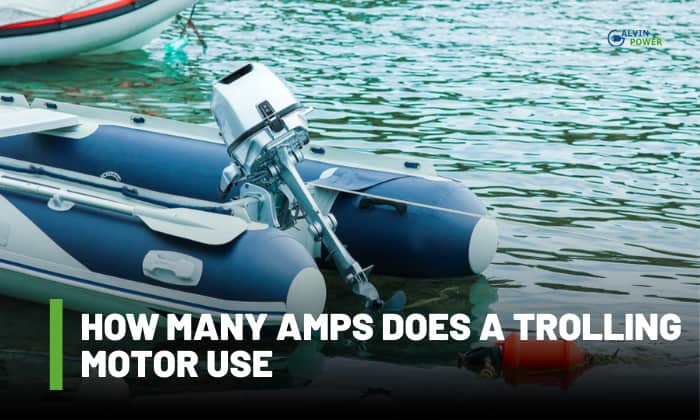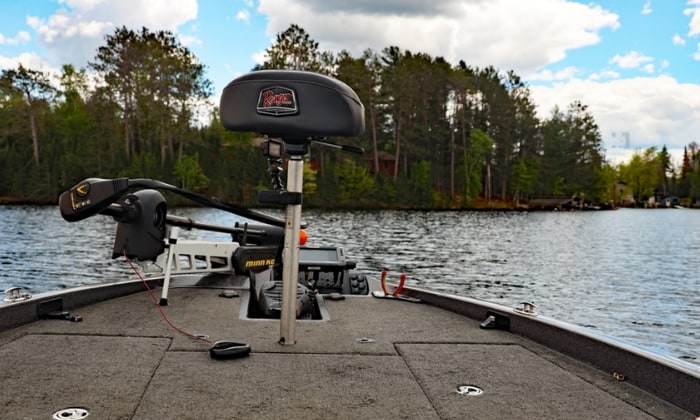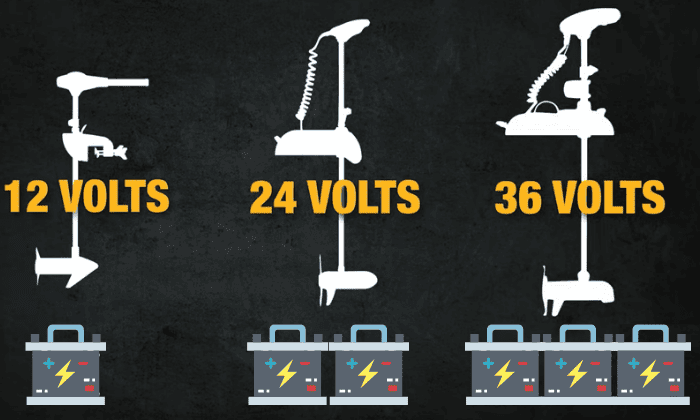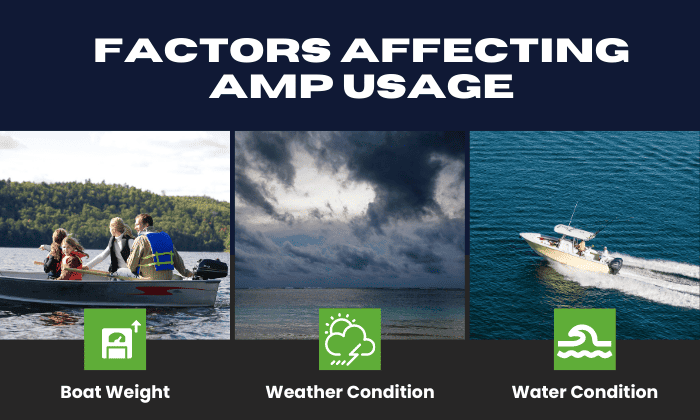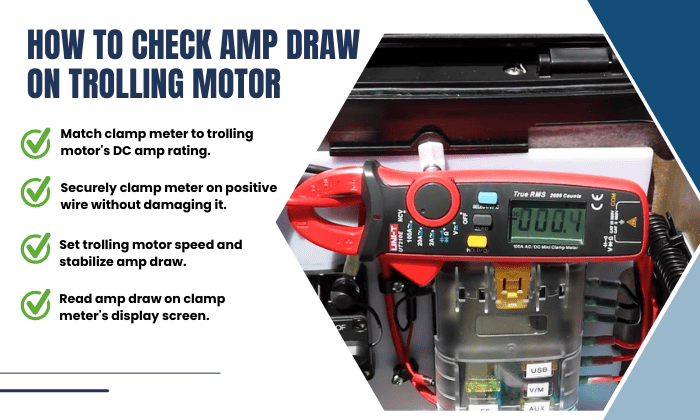Whether you are an avid angler or a boating enthusiast, a comprehensive understanding of every part of the boat is crucial for a safe trip. Regarding performance, one question that frequently arises is, “how many amps does a trolling motor use?”
It is good to understand various factors that may affect the amp draw of a trolling motor. In this case, let’s learn more about this device and what influences its amp usage.
Table of Contents
How Many Amps Does a Trolling Motor Draw?
The amp draw of a trolling motor can vary based on factors such as motor size, power rating, and operating speed. On average, trolling motors consume approximately 10 to 15 amps at lower speeds, 15 to 25 amps at medium speeds, and up to 60 amps at maximum speed.
However, it’s important to remember that actual amp draw values can vary depending on the specific motor and your boat’s needs. Below is a sample trolling motor amp draw chart featuring popular brands currently available.
| Trolling Motor Brand | Thrust | Voltage Rating | Estimated Amperage Draw | Recommended Circuit Breaker | ||
| Low Speed | Medium Speed | Max Speed | ||||
| Garmin Force | 100 lb | 36V | 13 amps | 27 amps | 54 amps | 60 amps |
| 80 lb | 24v | 14 amps | 28 amps | 57 amps | 60 amps | |
| Haswing | 55 lb | 12v | 13 amps | 27 amps | 55 amps | 60 amps |
| Lowrance Ghost | 120 lb | 36v | 10 amps | 21 amps | 43 amps | 50 amps |
| Minn Kota | 30 lb | 12V | 7 amps | 15 amps | 30 amps | 40 amps |
| 70 lb | 24V | 10 amps | 21 amps | 42 amps | 50 amps | |
| 40 lb -45 lb | 12V | 10 amps | 21 amps | 42 amps | 50 amps | |
| 101 lb | 36V | 11 amps | 23 amps | 46 amps | 50 amps | |
| 50-55 lb | 12v | 12 amps | 25 amps | 50 amps | 60 amps | |
| 112 lb | 36v | 13 amps | 26 amps | 52 amps | 60 amps | |
| 80 lb | 24v | 14 amps | 28 amps | 56 amps | 60 amps | |
| Motor Guide | 70 lb | 24v | 10 amps | 21 amps | 42 amps | 50 amps |
| 55 lb | 12v | 13 amps | 26 amps | 52 amps | 60 amps | |
| Newport Vessels | 40 lb | 12v | 8 amps | 17 amps | 34 amps | 40 amps |
| 46 lb | 12v | 10 amps | 20 amps | 40 amps | 50 amps | |
| 86 lb | 24v | 12 amps | 24 amps | 48 amps | 50 amps | |
| 55 lb | 12v | 13 amps | 26 amps | 52 amps | 60 amps | |
| 62 lb | 12v | 14 amps | 29 amps | 58 amps | 60 amps | |
| 36 lb | 12v | 7 amps | 14 amps | 29 amps | 40 amps | |
| Watersnake | 24 lb | 12v | 5 amps | 10 amps | 20 amps | 30 amps |
Please remember that these speed chart values are approximate, and referring to the manufacturer’s specifications for the most accurate information regarding amp draw is always recommended.
Amp Usage for Different Trolling Motor Types
Trolling motors are available in different voltage ratings, such as 36v, 24v, and 12v trolling motor. It’s important to understand that each type requires a specific amp rating for the battery.
- For a 12V motor with a 30 lb thrust up to 55 lb thrust, it is recommended to have a single battery with a minimum rating of 35 Ah to provide one hour of usage.
- In the case of a 24V motor with a thrust of 80 lb, you will typically need two batteries connected in a series. Each battery should have an amp hour rating of at least 35 Ah to ensure one hour of usage.
- Lastly, for a 36V motor with a thrust level of 112 lbs, a minimum of three batteries with a rating of 35 Ah each is required. These batteries should be connected in series to provide one hour of usage.
To calculate the runtime of your motor, you can divide the battery’s amp hour rating by the amp rating of your trolling motor at a specific speed. You can refer to the amp draw chart above for the motor’s current rating.
Alternatively, you can utilize a run time calculator for quicker results. These calculators can be found easily on the internet and provide a convenient way to estimate the motor’s runtime based on its amp draw and the battery’s amp hour rating.
Factors Affecting Amp Usage
- Boat Weight
The weight of the boat can affect the amp draw of the trolling motor. A heavier vessel will require more power to propel, leading to a higher amp draw. In contrast, lighter boats tend to have lower amp draw requirements as they are easy to push.
- Weather Condition
It is good to understand that strong winds cause resistance against the boat, requiring the motor to work harder and consume more power to maintain the target speed or overcome the wind resistance.
- Water Condition
Lastly, trolling motor amp draw can be influenced by water conditions such as currents, waves, and water types. Navigating in stormy water or against strong currents necessitates more power, which might result in a higher amp draw.
Calculating Amps Used by a Trolling Motor
Calculating the amp draw of a trolling motor typically depends on how many watts the device is. However, since horsepower is commonly used to measure motor power, we need to convert horsepower to watts before estimating the amp rating.
Here’s a formula you can use to calculate the amp rating:
\[ \frac{{Hp \times 746}}{{\text{{motor’s efficiency}}}} = \text{{Watts}} \]
\[ \frac{{\text{{Watts}}}}{{\text{{Volts}}}} = \text{{Amps}} \]
- For instance, let’s consider a 12V motor with a 36 lb thrust, equivalent to 0.48 HP at maximum speed. To calculate the amp draw, 0.48 HP multiplied by 746 watts equals 358.08 watts.
We divide the trolling motor wattage (358.08 watts) by the voltage (12V) to get an estimated amp draw of 29.84 amps at full speed.
- Another example involves a 24V trolling motor with 80 lb thrust, which is equivalent to 1.10 HP. The calculation would be:
1.10 HP divided by 80% efficiency, multiplied by 746 watts per horsepower, results in a total wattage of 1025.75 watts. Divide the wattage (1025.75 watts) by the voltage (24V) to get a total current draw of 42.7 amps.
Note: These calculations provide estimated amp draws for trolling motors. To obtain the actual current draw of your specific equipment, you can use a clamp meter, which accurately measures the current flowing through the motor.
How to Check Amp Draw on Trolling Motor
To check the trolling motor amps, using a clamp meter can be helpful. Also, ensure that your boat propeller is submerged adequately in a tub or container filled with water. This setup allows for accurate measurement of the motor’s amp draw. Then follow these steps:
- Set the clamp meter to the appropriate DC reading, specifically matching the amp rating of your trolling motor.
- Identify the positive wire connection and securely clamp the meter around it. Take care not to damage the wire while ensuring a firm connection.
- Turn on the trolling motor and set it to your desired speed, stabilizing the amp draw.
- Finally, read the amp draw of your trolling motor on the display screen of the clamp meter.
Frequently Asked Questions
How Long Will a Trolling Motor Run on One Battery?
In general, a standard battery with a capacity of 110 amp hours has a trolling motor run time of approximately 8 hours. However, it is good to understand that several factors, including battery capacity and motor usage, influence the runtime of a trolling motor.
Choosing the Right Trolling Motor Based on Amperage
Basically, when choosing the right trolling motor, it is essential to consider the size of the boat and the battery it can hold. A higher trolling motor current draw will demand a bigger battery.
How to Maximize the Efficiency and Lifespan of a Trolling Motor?
To enhance the efficiency and lifespan of your trolling motor, consider regular maintenance, including cleaning, replacing damaged parts, tightening bolts, and applying lubricants to the motor. It would also be helpful to disconnect and charge the battery when it’s not in use for a more reliable battery run time.
Can I Use a Higher Amperage Battery with My Trolling Motor?
Yes. It is essential to use a higher amperage or higher battery capacity (around 125 Ah). Doing so will give the trolling motor power for longer hours, increasing the time you can spend fishing.
Conclusion
In conclusion, knowing how many amps does a trolling motor use can guide you on how long you can use your trolling motor before you run out of power. This also allows you to choose a battery with a capacity that suits your needs.
If you are undecided between a 12v vs 24v trolling motor, consider factors such as the size of your boat and the prevailing weather conditions in your area. A 12v motor is typically suitable for smaller boats up to 16 ft in length and moderate wind conditions. Conversely, a 24v motor is recommended for larger boats and stronger winds.

I am Edwin Jones, in charge of designing content for Galvinpower. I aspire to use my experiences in marketing to create reliable and necessary information to help our readers. It has been fun to work with Andrew and apply his incredible knowledge to our content.

